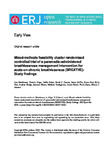Mixed-methods feasibility cluster randomised controlled trial of a paramedic-administered breathlessness management intervention for acute-on-chronic breathlessness (BREATHE): Study findings
| dc.contributor.author | Hutchinson, A | |
| dc.contributor.author | Allgar, Victoria | |
| dc.contributor.author | Cohen, J | |
| dc.contributor.author | Currow, DC | |
| dc.contributor.author | Griffin, S | |
| dc.contributor.author | Hart, S | |
| dc.contributor.author | Hird, K | |
| dc.contributor.author | Hodge, A | |
| dc.contributor.author | Mason, S | |
| dc.contributor.author | Northgraves, M | |
| dc.contributor.author | Reeve, J | |
| dc.contributor.author | Swan, F | |
| dc.contributor.author | Johnson, MJ | |
| dc.date.accessioned | 2022-10-28T12:41:27Z | |
| dc.date.available | 2022-10-28T12:41:27Z | |
| dc.date.issued | 2022-08-24 | |
| dc.identifier.issn | 2312-0541 | |
| dc.identifier.issn | 2312-0541 | |
| dc.identifier.other | ARTN 00257-2022 | |
| dc.identifier.uri | http://hdl.handle.net/10026.1/19776 | |
| dc.description.abstract |
<jats:sec><jats:title>Introduction</jats:title><jats:p>One-fifth of emergency department presentations by ambulance are due to acute-on-chronic breathlessness. We explored the feasibility of an evaluation-phase, cluster randomised controlled trial (cRCT) of the effectiveness and cost-effectiveness of a paramedic-administered, non-pharmacological breathlessness intervention for people with acute-on-chronic breathlessness at ambulance call-out (BREATHE) regarding breathlessness intensity and conveyance to hospital.</jats:p></jats:sec><jats:sec><jats:title>Methods</jats:title><jats:p>This mixed-methods, feasibility cRCT (<jats:ext-link xmlns:xlink="http://www.w3.org/1999/xlink" ext-link-type="isrctn" xlink:href="80330546">ISRCTN80330546</jats:ext-link>), randomised paramedics to usual care or intervention plus usual care. Retrospective patient consent to use call-out data (primary endpoint) and prospective patient/carer consent for follow-up was sought. Potential primary outcomes included breathlessness intensity (numerical rating scale) and conveyance. Follow-up included: interviews with patients/carers and questionnaires at 14 days, 1 and 6 months; paramedic focus groups and surveys.</jats:p></jats:sec><jats:sec><jats:title>Results</jats:title><jats:p>Recruitment was during COVID-19, with high demands on paramedics and fewer call-outs by eligible patients. We enrolled 29 paramedics; nine withdrew. Randomisation/trial procedures were acceptable.</jats:p><jats:p>Paramedics recruited thirteen patients, not meeting recruitment target (n=36); eight patients and three carers were followed up. Data quality was good but insufficient for future sample size estimation.</jats:p><jats:p>The intervention did not extend call-out time, was delivered with fidelity and was acceptable to patients, carers and paramedics. There were no repeat call-outs within 48 h. All trained paramedics strongly recommended BREATHE as a highly relevant, simple intervention.</jats:p></jats:sec><jats:sec><jats:title>Conclusion</jats:title><jats:p>Patient recruitment to target was not feasible during the pandemic. Training and intervention were acceptable and delivered with fidelity. Results include valuable information on recruitment, consent, attrition, and data collection that will inform the design and delivery of a definitive trial.</jats:p></jats:sec> | |
| dc.format.extent | 00257-2022 | |
| dc.format.medium | Electronic-eCollection | |
| dc.language | en | |
| dc.language.iso | en | |
| dc.publisher | European Respiratory Society | |
| dc.subject | Clinical Research | |
| dc.subject | Clinical Trials and Supportive Activities | |
| dc.subject | 7.3 Management and decision making | |
| dc.title | Mixed-methods feasibility cluster randomised controlled trial of a paramedic-administered breathlessness management intervention for acute-on-chronic breathlessness (BREATHE): Study findings | |
| dc.type | journal-article | |
| dc.type | Journal Article | |
| plymouth.author-url | https://www.webofscience.com/api/gateway?GWVersion=2&SrcApp=PARTNER_APP&SrcAuth=LinksAMR&KeyUT=WOS:000890924100017&DestLinkType=FullRecord&DestApp=ALL_WOS&UsrCustomerID=11bb513d99f797142bcfeffcc58ea008 | |
| plymouth.issue | 4 | |
| plymouth.volume | 8 | |
| plymouth.publication-status | Published | |
| plymouth.journal | ERJ Open Research | |
| dc.identifier.doi | 10.1183/23120541.00257-2022 | |
| plymouth.organisational-group | /Plymouth | |
| plymouth.organisational-group | /Plymouth/Faculty of Health | |
| plymouth.organisational-group | /Plymouth/Faculty of Health/Peninsula Medical School | |
| plymouth.organisational-group | /Plymouth/REF 2021 Researchers by UoA | |
| plymouth.organisational-group | /Plymouth/REF 2021 Researchers by UoA/UoA01 Clinical Medicine | |
| plymouth.organisational-group | /Plymouth/Research Groups | |
| plymouth.organisational-group | /Plymouth/Research Groups/Plymouth Institute of Health and Care Research (PIHR) | |
| plymouth.organisational-group | /Plymouth/Users by role | |
| plymouth.organisational-group | /Plymouth/Users by role/Academics | |
| dc.publisher.place | England | |
| dcterms.dateAccepted | 2022-08-11 | |
| dc.rights.embargodate | 2022-10-29 | |
| dc.identifier.eissn | 2312-0541 | |
| dc.rights.embargoperiod | Not known | |
| rioxxterms.versionofrecord | 10.1183/23120541.00257-2022 | |
| rioxxterms.licenseref.uri | http://www.rioxx.net/licenses/all-rights-reserved | |
| rioxxterms.type | Journal Article/Review |


